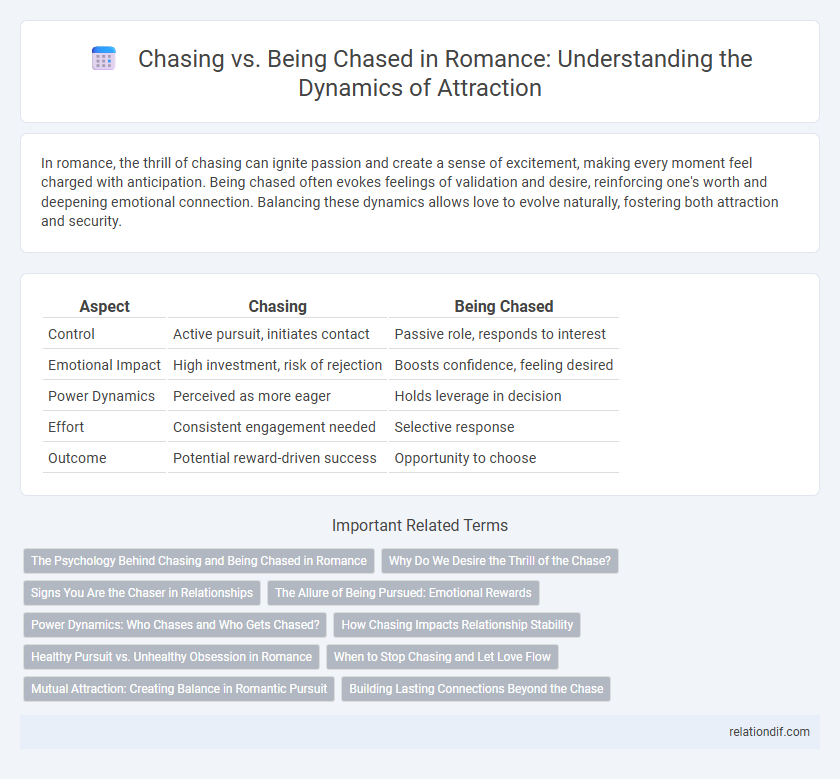In romance, the thrill of chasing can ignite passion and create a sense of excitement, making every moment feel charged with anticipation. Being chased often evokes feelings of validation and desire, reinforcing one's worth and deepening emotional connection. Balancing these dynamics allows love to evolve naturally, fostering both attraction and security.
Table of Comparison
| Aspect | Chasing | Being Chased |
|---|---|---|
| Control | Active pursuit, initiates contact | Passive role, responds to interest |
| Emotional Impact | High investment, risk of rejection | Boosts confidence, feeling desired |
| Power Dynamics | Perceived as more eager | Holds leverage in decision |
| Effort | Consistent engagement needed | Selective response |
| Outcome | Potential reward-driven success | Opportunity to choose |
The Psychology Behind Chasing and Being Chased in Romance
The psychology behind chasing and being chased in romance revolves around the dynamics of desire, control, and validation, where the pursuer seeks affirmation while the pursued experiences heightened attraction through perceived scarcity. Chasing triggers dopamine release, enhancing excitement and anticipation, whereas being chased often satisfies deeper psychological needs for security and self-worth. Understanding these underlying mechanisms helps decode romantic behaviors and can lead to healthier relationship patterns by balancing pursuit and reciprocation.
Why Do We Desire the Thrill of the Chase?
The thrill of the chase in romance triggers dopamine release, intensifying feelings of excitement and attraction that often diminish with stability. Pursuing a partner satisfies primal instincts linked to achievement and reward, making the process emotionally stimulating and psychologically engaging. Being chased shifts dynamics, offering validation and security, but lacks the adrenaline rush that drives the desire to compete and win affection.
Signs You Are the Chaser in Relationships
Constantly initiating contact, planning dates, and making efforts to maintain communication often indicate you are the chaser in the relationship. Feeling the need to confirm your partner's feelings or frequently interpreting ambiguous responses as signs of disinterest also signals chasing behavior. When you invest more emotional energy and time while your partner remains passive or unresponsive, it highlights an imbalance where you are pursuing more than being pursued.
The Allure of Being Pursued: Emotional Rewards
Experiencing the thrill of being pursued in romance taps into deep psychological needs for validation and desire, heightening emotional intimacy and self-worth. The allure of being chased amplifies feelings of exclusivity and excitement, fostering a stronger emotional connection between partners. This dynamic often leads to increased dopamine release, reinforcing the rewarding sensation of attention and affection.
Power Dynamics: Who Chases and Who Gets Chased?
Power dynamics in romance hinge on the roles of chaser and chased, where the pursuer holds a subtle advantage by driving the interaction and signaling desire. The one being chased often gains emotional leverage through mystery and selective availability, creating tension and attraction. Understanding these roles reveals how control and vulnerability interplay, shaping intimacy and relationship progression.
How Chasing Impacts Relationship Stability
Chasing in romance often creates an imbalance of power, leading to insecurity and instability within the relationship. When one partner pursues aggressively, it can trigger feelings of pressure and resistance, undermining trust and emotional connection. Stability thrives when mutual interest and respect replace relentless chasing behaviors.
Healthy Pursuit vs. Unhealthy Obsession in Romance
Healthy pursuit in romance involves mutual respect, clear communication, and balanced effort from both partners, fostering genuine connection and growth. Unhealthy obsession manifests as controlling behavior, constant monitoring, and ignoring boundaries, leading to emotional distress and relationship instability. Recognizing these differences is crucial for maintaining a fulfilling and respectful romantic bond.
When to Stop Chasing and Let Love Flow
Recognizing when to stop chasing in a romantic pursuit is crucial for maintaining emotional balance and self-respect. Persistent pursuit can create imbalance and diminish attraction, while allowing love to flow naturally fosters genuine connection and mutual desire. Understanding the subtle signs of disinterest and respecting personal boundaries empowers individuals to embrace authentic relationships rather than forcing affection.
Mutual Attraction: Creating Balance in Romantic Pursuit
Mutual attraction thrives when both partners actively participate in the romantic pursuit, fostering a balanced dynamic where desire and effort are equally shared. This equilibrium prevents one-sided chase, promoting emotional connection and respect while enhancing intimacy and trust. Balanced reciprocal interest creates a foundation for sustainable, healthy relationships grounded in genuine affection rather than imbalance or pressure.
Building Lasting Connections Beyond the Chase
Chasing romance often creates fleeting excitement, while being chased fosters genuine connection and trust. Building lasting relationships depends on mutual respect and emotional vulnerability rather than pursuit alone. True love thrives when both partners feel equally valued and embraced beyond the initial chase.
chasing vs being chased Infographic

 relationdif.com
relationdif.com